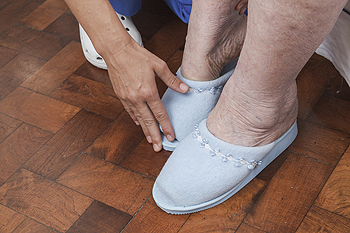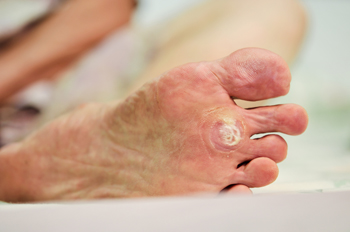Blog
Arthritis Can Cause Pain in the Feet and Ankles
Children and Shoes
 The best shoes for children will always meet their physical needs as their feet develop. Babies will benefit when they can walk barefoot while indoors, as this can help to strengthen the overall foot as the toes grip the floor. When your child starts to walk outside, it can be beneficial to choose a shoe that is made from good quality materials, in addition to ensuring that the sole is not too stiff. Shoe styles can vary, and it is helpful to get your child’s feet professionally measured, followed by trying on and walking in the shoes before any purchases are made. The feet are the foundation of the body, and shoes need to be changed as the feet grow. This allows the feet to have ample room to move and grow. If you would like additional information about what type of shoes to buy for your child, it is suggested that you confer with a podiatrist who can guide you toward the right shoes for your child.
The best shoes for children will always meet their physical needs as their feet develop. Babies will benefit when they can walk barefoot while indoors, as this can help to strengthen the overall foot as the toes grip the floor. When your child starts to walk outside, it can be beneficial to choose a shoe that is made from good quality materials, in addition to ensuring that the sole is not too stiff. Shoe styles can vary, and it is helpful to get your child’s feet professionally measured, followed by trying on and walking in the shoes before any purchases are made. The feet are the foundation of the body, and shoes need to be changed as the feet grow. This allows the feet to have ample room to move and grow. If you would like additional information about what type of shoes to buy for your child, it is suggested that you confer with a podiatrist who can guide you toward the right shoes for your child.
Making sure that your children maintain good foot health is very important as they grow. If you have any questions, contact Dr. Tupper of Coshocton Foot Health Center. Our doctor can provide the care you need to keep you pain-free and on your feet.
Keeping Children's Feet Healthy
Having healthy feet during childhood can help prevent medical problems later in life, namely in the back and legs. As children grow, their feet require different types of care. Here are some things to consider...
Although babies do not walk yet, it is still very important to take care of their feet.
Avoid putting tight shoes or socks on his or her feet.
Allow the baby to stretch and kick his or her feet to feel comfortable.
As a toddler, kids are now on the move and begin to develop differently. At this age, toddlers are getting a feel for walking, so don’t be alarmed if your toddler is unsteady or ‘walks funny’.
As your child gets older, it is important to teach them how to take care of their feet.
Show them proper hygiene to prevent infections such as fungus.
Be watchful for any pain or injury.
Have all injuries checked by a doctor as soon as possible.
Comfortable, protective shoes should always be worn, especially at play.
If you have any questions please feel free to contact our office located in Coshocton, OH . We offer the newest diagnostic and treatment technologies for all your foot and ankle needs.
Contagious Toenail Fungus
 Research has indicated that millions of people worldwide are affected by toenail fungus. It is an unsightly condition that typically begins with symptoms showing in the big toe. These can include a change in nail texture and color, in addition to becoming thick, brittle, and gradually crumble. It is caused by a fungus that lives and thrives in warm and moist environments, consisting of public swimming pools, shower room floors, and surrounding areas. It is considered to be contagious, and can enter the body through tiny cracks in the skin on the feet. Treatment can begin with changing the socks and shoes daily, and properly trimming the toenails. If you are afflicted with toenail fungus, it is strongly advised that you are under the care of a podiatrist who can guide you toward the correct treatment technique.
Research has indicated that millions of people worldwide are affected by toenail fungus. It is an unsightly condition that typically begins with symptoms showing in the big toe. These can include a change in nail texture and color, in addition to becoming thick, brittle, and gradually crumble. It is caused by a fungus that lives and thrives in warm and moist environments, consisting of public swimming pools, shower room floors, and surrounding areas. It is considered to be contagious, and can enter the body through tiny cracks in the skin on the feet. Treatment can begin with changing the socks and shoes daily, and properly trimming the toenails. If you are afflicted with toenail fungus, it is strongly advised that you are under the care of a podiatrist who can guide you toward the correct treatment technique.
If left untreated, toenail fungus may spread to other toenails, skin, or even fingernails. If you suspect you have toenail fungus it is important to seek treatment right away. For more information about treatment, contact Dr. Tupper of Coshocton Foot Health Center. Our doctor can provide the care you need to keep you pain-free and on your feet.
Symptoms
- Warped or oddly shaped nails
- Yellowish nails
- Loose/separated nail
- Buildup of bits and pieces of nail fragments under the nail
- Brittle, broken, thickened nail
Treatment
If self-care strategies and over-the-counter medications does not help your fungus, your podiatrist may give you a prescription drug instead. Even if you find relief from your toenail fungus symptoms, you may experience a repeat infection in the future.
Prevention
In order to prevent getting toenail fungus in the future, you should always make sure to wash your feet with soap and water. After washing, it is important to dry your feet thoroughly especially in between the toes. When trimming your toenails, be sure to trim straight across instead of in a rounded shape. It is crucial not to cover up discolored nails with nail polish because that will prevent your nail from being able to “breathe”.
In some cases, surgical procedure may be needed to remove the toenail fungus. Consult with your podiatrist about the best treatment options for your case of toenail fungus.
If you have any questions, please feel free to contact our office located in Coshocton, OH . We offer the newest diagnostic and treatment technologies for all your foot care needs.
What Are the Symptoms of Tarsal Tunnel Syndrome?
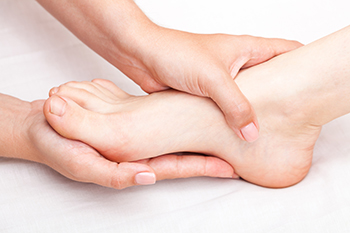 Tarsal tunnel syndrome may not be a commonly known ailment, but have you heard of carpal tunnel syndrome? Carpal tunnel affects the hands while tarsal tunnel syndrome occurs in the feet and can cause pain and discomfort. Research has indicated that people who have arthritis may be prone to developing this condition, in addition to frequently enduring high-stress activities. Some of the symptoms that are associated with this ailment often include tired feet and ankles, and the overall foot may be numb or have tingling sensations. Some patients have pain in the Achilles tendon area, and the ankles may appear swollen. There are several symptoms that can be associated with tarsal tunnel syndrome so it is strongly suggested that you consult with a podiatrist when they first develop. This type of doctor can properly diagnose and effectively treat this condition.
Tarsal tunnel syndrome may not be a commonly known ailment, but have you heard of carpal tunnel syndrome? Carpal tunnel affects the hands while tarsal tunnel syndrome occurs in the feet and can cause pain and discomfort. Research has indicated that people who have arthritis may be prone to developing this condition, in addition to frequently enduring high-stress activities. Some of the symptoms that are associated with this ailment often include tired feet and ankles, and the overall foot may be numb or have tingling sensations. Some patients have pain in the Achilles tendon area, and the ankles may appear swollen. There are several symptoms that can be associated with tarsal tunnel syndrome so it is strongly suggested that you consult with a podiatrist when they first develop. This type of doctor can properly diagnose and effectively treat this condition.
Tarsal tunnel syndrome can be very uncomfortable to live with. If you are experiencing tarsal tunnel syndrome, contact Dr. Tupper of Coshocton Foot Health Center. Our doctor can provide the care you need to keep you pain-free and on your feet.
Tarsal Tunnel Syndrome
Tarsal tunnel syndrome, which can also be called tibial nerve dysfunction, is an uncommon condition of misfiring peripheral nerves in the foot. The tibial nerve is the peripheral nerve in the leg responsible for sensation and movement of the foot and calf muscles. In tarsal tunnel syndrome, the tibial nerve is damaged, causing problems with movement and feeling in the foot of the affected leg.
Common Cause of Tarsal Tunnel Syndrome
- Involves pressure or an injury, direct pressure on the tibial nerve for an extended period of time, sometimes caused by other body structures close by or near the knee.
- Diseases that damage nerves, including diabetes, may cause tarsal tunnel syndrome.
- At times, tarsal tunnel syndrome can appear without an obvious cause in some cases.
The Effects of Tarsal Tunnel Syndrome
- Different sensations, an afflicted person may experience pain, tingling, burning or other unusual sensations in the foot of the affected leg.
- The foot muscles, toes and ankle become weaker, and curling your toes or flexing your foot can become difficult.
- If condition worsens, infections and ulcers may develop on the foot that is experiencing the syndrome.
A physical exam of the leg can help identify the presence of tarsal tunnel syndrome. Medical tests, such as a nerve biopsy, are also used to diagnose the condition. Patients may receive physical therapy and prescriptive medication. In extreme cases, some may require surgery.
If you have any questions please feel free to contact our office located in Coshocton, OH . We offer the newest diagnostic and treatment technologies for all your foot and ankle needs.
Gout Pain Can Be Managed
Lending a Hand to Care for Feet in the Elderly
Helping your favorite senior citizen take care of their feet can improve their quality of life, help keep them safe and comfortable, and may even lead to early detection of systemic conditions that affect the feet. To protect their feet from injury, make sure they wear properly-fitted shoes at all times. Socks should not be tight at the ankle or leg, and they should be the moisture-wicking kind that transfers moisture to the outside of the sock. Keep their toenails trimmed, but not too short, to avoid ingrown toenails. Have them do stretches a few times a day for their feet and toes to keep the blood flowing (a podiatrist should be consulted first) and reward them with a relaxing foot bath which can relieve muscles and soothe bunions and dry skin. It is important to examine the bottom of the older adult’s feet regularly to check for cracks, cuts, blisters and sores and bring them to a podiatrist if anything unusual or concerning develops.
Proper foot care is something many older adults forget to consider. If you have any concerns about your feet and ankles, contact Dr. Tupper from Coshocton Foot Health Center. Our doctor can provide the care you need to keep you pain-free and on your feet.
The Elderly and Their Feet
As we age we start to notice many changes in our body, but the elder population may not notice them right away. Medical conditions may prevent the elderly to take notice of their foot health right away. Poor vision is a lead contributor to not taking action for the elderly.
Common Conditions
- Neuropathy – can reduce feeling in the feet and can hide many life-threatening medical conditions.
- Reduced flexibility – prevents the ability of proper toenail trimming, and foot cleaning. If left untreated, it may lead to further medical issues.
- Foot sores – amongst the older population can be serious before they are discovered. Some of the problematic conditions they may face are:
- Gouging toenails affecting nearby toe
- Shoes that don’t fit properly
- Pressure sores
- Loss of circulation in legs & feet
- Edema & swelling of feet and ankles
Susceptible Infections
Diabetes and poor circulation can cause general loss of sensitivity over the years, turning a simple cut into a serious issue.
If you have any questions please feel free to contact our office located in Coshocton, OH . We offer the newest diagnostic and treatment technologies for all your foot and ankle needs.
Why Does My Pinky Toe Hurt?
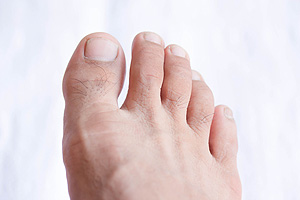 Although the pinky toe is small, an injury to this toe can be very painful. Stubbing your toe, dropping something heavy on it, hitting it while playing a sport, or wearing tight shoes can all cause pinky toe pain. Common causes of pinky toe pain may include a toe fracture, in which the toe bone is fully broken, or a stress fracture, in which the bone has one or more tiny cracks. Your toe can also hurt if it has been dislocated or sprained. A specific type of bunion, called a tailor’s bunion or bunionette, can form on the pinky toe, as can corns and calluses. If you are experiencing pain in any of your toes, please see a podiatrist, who can diagnose and treat your condition.
Although the pinky toe is small, an injury to this toe can be very painful. Stubbing your toe, dropping something heavy on it, hitting it while playing a sport, or wearing tight shoes can all cause pinky toe pain. Common causes of pinky toe pain may include a toe fracture, in which the toe bone is fully broken, or a stress fracture, in which the bone has one or more tiny cracks. Your toe can also hurt if it has been dislocated or sprained. A specific type of bunion, called a tailor’s bunion or bunionette, can form on the pinky toe, as can corns and calluses. If you are experiencing pain in any of your toes, please see a podiatrist, who can diagnose and treat your condition.
Broken toes may cause a lot of pain and should be treated as soon as possible. If you have any concerns about your feet, contact Dr. Tupper from Coshocton Foot Health Center. Our doctor will treat your foot and ankle needs.
What Is a Broken Toe?
A broken toe occurs when one or more of the toe bones of the foot are broken after an injury. Injuries such as stubbing your toe or dropping a heavy object on it may cause a toe fracture.
Symptoms of a Broken Toe
- Swelling
- Pain (with/without wearing shoes)
- Stiffness
- Nail Injury
Although the injured toe should be monitored daily, it is especially important to have a podiatrist look at your toe if you have severe symptoms. Some of these symptoms include worsening or new pain that is not relieved with medication, sores, redness, or open wounds near the toe.
If you have any questions, please feel free to contact our office located in Coshocton, OH . We offer the newest diagnostic and treatment technologies for all your foot care needs.
How the Achilles Tendon Can Be Injured
 The Achilles tendon is located on the back of the ankle and connects the heel to the calf muscles. The two most common injuries that affect the Achilles tendon are Achilles tendinopathy and an Achilles tendon tear or rupture. Achilles tendinopathy symptoms include swelling, stiffness, and pain that is more noticeable in the morning. An Achilles tendon tear or rupture is often the result of forceful jumping and pivoting and sudden accelerations that result in overstretching and the eventual tearing of the tendon. A complete rupture can cause severe pain and a loss of strength and movement. Because of the seriousness of an Achilles tendon injury, patients who are experiencing pain and swelling in this tendon should consult with a podiatrist. A podiatrist will be able to help provide preventative measures to avoid a rupture, as well as guide you in healing the injury.
The Achilles tendon is located on the back of the ankle and connects the heel to the calf muscles. The two most common injuries that affect the Achilles tendon are Achilles tendinopathy and an Achilles tendon tear or rupture. Achilles tendinopathy symptoms include swelling, stiffness, and pain that is more noticeable in the morning. An Achilles tendon tear or rupture is often the result of forceful jumping and pivoting and sudden accelerations that result in overstretching and the eventual tearing of the tendon. A complete rupture can cause severe pain and a loss of strength and movement. Because of the seriousness of an Achilles tendon injury, patients who are experiencing pain and swelling in this tendon should consult with a podiatrist. A podiatrist will be able to help provide preventative measures to avoid a rupture, as well as guide you in healing the injury.
Achilles tendon injuries need immediate attention to avoid future complications. If you have any concerns, contact Dr. Tupper of Coshocton Foot Health Center. Our doctor can provide the care you need to keep you pain-free and on your feet.
What Is the Achilles Tendon?
The Achilles tendon is a tendon that connects the lower leg muscles and calf to the heel of the foot. It is the strongest tendon in the human body and is essential for making movement possible. Because this tendon is such an integral part of the body, any injuries to it can create immense difficulties and should immediately be presented to a doctor.
What Are the Symptoms of an Achilles Tendon Injury?
There are various types of injuries that can affect the Achilles tendon. The two most common injuries are Achilles tendinitis and ruptures of the tendon.
Achilles Tendinitis Symptoms
- Inflammation
- Dull to severe pain
- Increased blood flow to the tendon
- Thickening of the tendon
Rupture Symptoms
- Extreme pain and swelling in the foot
- Total immobility
Treatment and Prevention
Achilles tendon injuries are diagnosed by a thorough physical evaluation, which can include an MRI. Treatment involves rest, physical therapy, and in some cases, surgery. However, various preventative measures can be taken to avoid these injuries, such as:
- Thorough stretching of the tendon before and after exercise
- Strengthening exercises like calf raises, squats, leg curls, leg extensions, leg raises, lunges, and leg presses
If you have any questions please feel free to contact our office located in Coshocton, OH . We offer the newest diagnostic tools and technology to treat your foot and ankle needs.
HPV and Plantar Warts
Plantar warts are caused by the human papillomavirus (HPV). They occur on the sole of the feet—most typically on the balls of the feet, heels, and under the toes—and are spread by human contact when the virus enters the bloodstream through tiny cracks in the skin. They usually present as hard, thick, lesions akin to calluses, and sometimes tiny blood vessels are present, which look like black specks on the surface. Plantar warts can range in size, and are often tender or sometimes even painful. They can form as either independent growths or as part of a cluster of warts. While plantar warts can sometimes go away over a period of years, it is suggested that you seek the care of a podiatrist if you have circulatory problems or diabetes, or if your warts are painful, bleeding, or spreading quickly.
Plantar warts can be very uncomfortable. If you need your feet checked, contact Dr. Tupper from Coshocton Foot Health Center. Our doctor will assist you with all of your foot and ankle needs.
About Plantar Warts
Plantar warts are the result of HPV, or human papillomavirus, getting into open wounds on the feet. They are mostly found on the heels or balls of the feet.
While plantar warts are generally harmless, those experiencing excessive pain or those suffering from diabetes or a compromised immune system require immediate medical care. Plantar warts are easily diagnosed, usually through scraping off a bit of rough skin or by getting a biopsy.
Symptoms
- Lesions on the bottom of your feet, usually rough and grainy
- Hard or thick callused spots
- Wart seeds, which are small clotted blood vessels that look like little black spots
- Pain, discomfort, or tenderness of your feet when walking or standing
Treatment
- Freezing
- Electric tool removal
- Laser Treatment
- Topical Creams (prescription only)
- Over-the-counter medications
To help prevent developing plantar warts, avoid walking barefoot over abrasive surfaces that can cause cuts or wounds for HPV to get into. Avoiding direct contact with other warts, as well as not picking or rubbing existing warts, can help prevent the further spread of plantar warts. However, if you think you have developed plantar warts, speak to your podiatrist. He or she can diagnose the warts on your feet and recommend the appropriate treatment options.
If you have any questions please feel free to contact our office located in Coshocton, OH . We offer the newest diagnostic and treatment technologies for all your foot and ankle needs.
Why Is My Toenail Ingrown?
Ingrown toenails occur when a nail grows into the surrounding skin, rather than over it. This can cause symptoms such as pain, tenderness, redness, and swelling of the skin surrounding the ingrown toenail. While most ingrown toenails are not serious and often heal with home treatment, sometimes the area can become infected and require medical treatment. But what causes toenails to become ingrown anyway? Trauma to the toenail from stubbing the toe can lead to ingrown nails, as can wearing shoes that are too tight and push the nail into the skin, and trimming the toenails improperly. If you are prone to ingrown toenails, it is suggested that you see a podiatrist, who can assess your feet and advise you on how to prevent and treat ingrown toenails.
Ingrown toenails can become painful if they are not treated properly. For more information about ingrown toenails, contact Dr. Tupper of Coshocton Foot Health Center. Our doctor can provide the care you need to keep you pain-free and on your feet.
Ingrown Toenails
Ingrown toenails occur when a toenail grows sideways into the bed of the nail, causing pain, swelling, and possibly infection.
Causes
- Bacterial infections
- Improper nail cutting such as cutting it too short or not straight across
- Trauma to the toe, such as stubbing, which causes the nail to grow back irregularly
- Ill-fitting shoes that bunch the toes too close together
- Genetic predisposition
Prevention
Because ingrown toenails are not something found outside of shoe-wearing cultures, going barefoot as often as possible will decrease the likeliness of developing ingrown toenails. Wearing proper fitting shoes and using proper cutting techniques will also help decrease your risk of developing ingrown toenails.
Treatment
Ingrown toenails are a very treatable foot condition. In minor cases, soaking the affected area in salt or antibacterial soaps will not only help with the ingrown nail itself, but also help prevent any infections from occurring. In more severe cases, surgery is an option. In either case, speaking to your podiatrist about this condition will help you get a better understanding of specific treatment options that are right for you.
If you have any questions please feel free to contact our office located in Coshocton, OH . We offer the newest diagnostic and treatment technologies for all your foot and ankle needs.
More...
Why Ankles Are so Important to Mobility
The ankle is a joint that connects the leg to the foot using a series of bones including the fibula, tibia, and the tarsal bones of the foot. The ankle is an integral part of a complex system that continually keeps our bodies balanced when we stand, and aids in our overall mobility. The foot needs the ankle in order to move up and down (dorsiflexion and plantarflexion), side-to-side (inversion and eversion), and to rotate either inward or outward (medially and laterally). Because of how active the ankle is in everyday movements as well as athletic activities, ankle injuries are quite common. Additionally, as we age, ankle mobility declines and makes us more prone to falling and other accidents. If you are experiencing any type of issue with your ankle, contact a podiatrist who can examine you and perform a variety of tests to detect any underlying cause of ankle pain, weakness, or mobility deterioration.
Foot and ankle trauma is common among athletes and the elderly. If you have concerns that you may have experienced trauma to the foot and ankle, consult with Dr. Tupper from Coshocton Foot Health Center. Our doctor will assess your condition and provide you with quality foot and ankle treatment.
Foot and ankle trauma cover a range of injuries all over the foot; common injuries include:
- Broken bones
- Muscle strains
- Injuries to the tendons and ligaments
- Stress fractures
Symptoms
Symptoms of foot and ankle injuries vary depending on the injury, but more common ones include:
- Bruising
- Inflammation/ Swelling
- Pain
Diagnosis
To properly diagnose the exact type of injury, podiatrists will conduct a number of different tests. Some of these include sensation and visual tests, X-rays, and MRIs. Medical and family histories will also be taken into account.
Treatment
Once the injury has been diagnosed, the podiatrist can than offer the best treatment options for you. In less severe cases, rest and keeping pressure off the foot may be all that’s necessary. Orthotics, such as a specially made shoes, or immobilization devices, like splints or casts, may be deemed necessary. Finally, if the injury is severe enough, surgery may be necessary.
If you have any questions, please feel free to contact our office located in Coshocton, OH . We offer the newest diagnostic and treatment technologies for all your foot care needs.
Are Bunions Affecting Your Everyday Life?
When Is Joint Replacement Surgery an Option?
When damage or disease in a joint does not improve or respond to conservative treatment, joint replacement surgery may be an option to help the patient feel and move better. In joint replacement surgery, damaged or diseased joints are replaced with fabricated parts in an effort to help the joint work better, while relieving pain and increasing or restoring mobility. Joint replacement surgery can typically be performed on many different joints in the body, including the joints in the ankles and big toes. These prosthetic joints can last many years. If you are suffering from joint pain in your feet or ankles, contact a podiatrist to see if you are a good candidate for joint replacement surgery.
In certain cases, in which the patient suffers from extreme pain or damage in a joint, joint replacement surgery may be deemed useful. If you have constant pain in a foot joint, consult with Dr. Tupper from Coshocton Foot Health Center. Our doctor will assess your condition and provide you with quality foot and ankle treatment.
What Is Joint Replacement Surgery?
Over time, joints wear down; this can be exacerbated by diseases and conditions. Joint replacement surgery, also known as arthroplasty, is when a damaged joint is surgically removed and replaced with a prosthesis. Prostheses, which can be made of ceramic, plastic, or metal, act as joints in lieu of an actual joint. One of the most prevalent causes for joint replacement is arthritis.
Arthritis in the Foot
Arthritis can occur in any joint in the body, including in the feet. Common types of arthritis in the foot are osteoarthritis, rheumatoid arthritis, and gout. The big toe is usually where arthritis occurs in the foot; this is known as hallux rigidus.
Joint Replacement Surgery in the Foot
The most common form of joint replacement in the foot is a first metatarsophalangeal (MTP) joint placement. MTP joint replacement surgery is designed to treat hallux rigidus. Surgery is not intensive, and recovery occurs within one to two months after the procedure has been done. Overall, joint replacement surgery is a safe and effective way to treat pain in the joint of the foot.
If you have any questions, please feel free to contact our office located in Coshocton, OH . We offer the newest diagnostic and treatment technologies for all your foot care needs.
Is Bunion Surgery an Option?
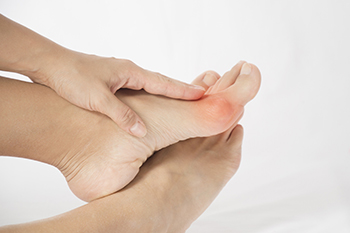 Patients who are afflicted with a bunion may choose to have surgery that can permanently repair this foot condition. A bunion is defined as a large, bony protrusion that develops on the bottom of the big toe. Common causes for a bunion to form can include genetic factors, or from wearing shoes that do not fit correctly. For severe bunions, many patients consider having surgery repair the affected joint. Additionally, bunion surgery may be successful in correcting the ligaments and tendons that may have shifted from the growing bunion. If you have a bunion, and are considering having surgery performed, it is strongly suggested that a podiatrist be consulted for an in depth discussion about the risks and rewards of bunion surgery.
Patients who are afflicted with a bunion may choose to have surgery that can permanently repair this foot condition. A bunion is defined as a large, bony protrusion that develops on the bottom of the big toe. Common causes for a bunion to form can include genetic factors, or from wearing shoes that do not fit correctly. For severe bunions, many patients consider having surgery repair the affected joint. Additionally, bunion surgery may be successful in correcting the ligaments and tendons that may have shifted from the growing bunion. If you have a bunion, and are considering having surgery performed, it is strongly suggested that a podiatrist be consulted for an in depth discussion about the risks and rewards of bunion surgery.
If you are suffering from bunions, contact Dr. Tupper of Coshocton Foot Health Center. Our doctor can provide the care you need to keep you pain-free and on your feet.
What Is a Bunion?
A bunion is formed of swollen tissue or an enlargement of boney growth, usually located at the base joint of the toe that connects to the foot. The swelling occurs due to the bones in the big toe shifting inward, which impacts the other toes of the foot. This causes the area around the base of the big toe to become inflamed and painful.
Why Do Bunions Form?
Genetics – Susceptibility to bunions are often hereditary
Stress on the feet – Poorly fitted and uncomfortable footwear that places stress on feet, such as heels, can worsen existing bunions
How Are Bunions Diagnosed?
Doctors often perform two tests – blood tests and x-rays – when trying to diagnose bunions, especially in the early stages of development. Blood tests help determine if the foot pain is being caused by something else, such as arthritis, while x-rays provide a clear picture of your bone structure to your doctor.
How Are Bunions Treated?
- Refrain from wearing heels or similar shoes that cause discomfort
- Select wider shoes that can provide more comfort and reduce pain
- Anti-inflammatory and pain management drugs
- Orthotics or foot inserts
- Surgery
If you have any questions, please feel free to contact our office located in Coshocton, OH . We offer the newest diagnostic and treatment technologies for all your foot care needs.


